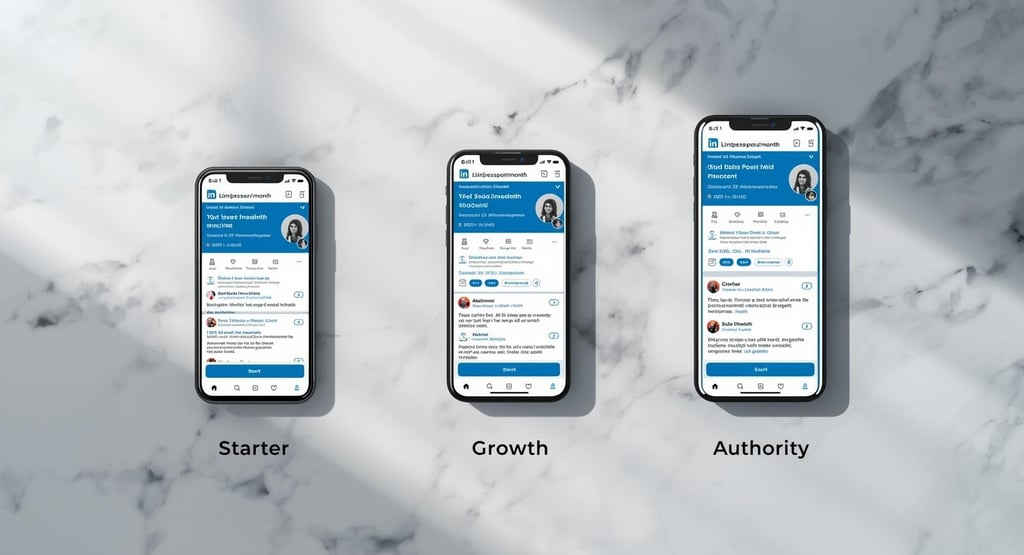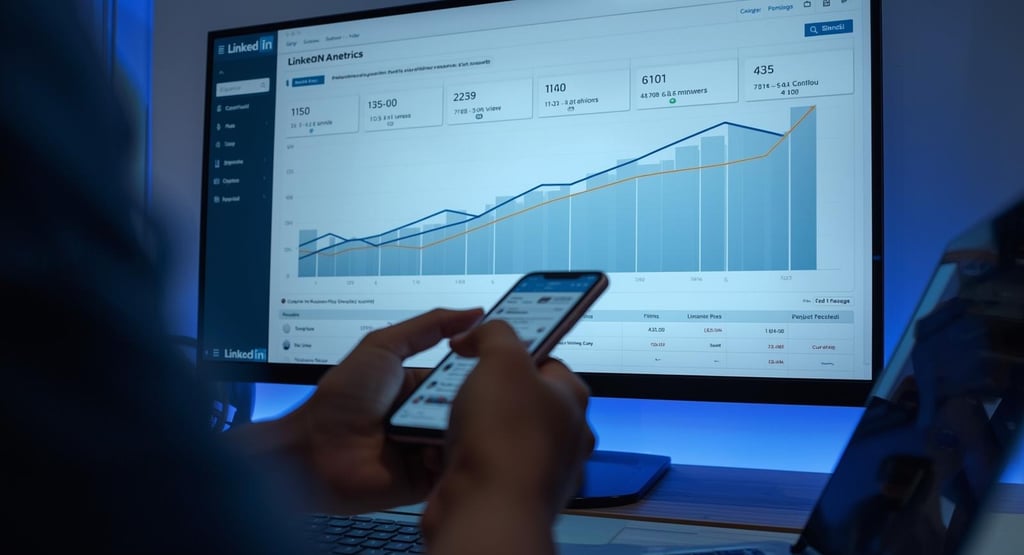How to Build a LinkedIn Presence That Actually Converts
Learn how to build a LinkedIn presence that actually converts leads. Discover the 30-day strategy helping professionals achieve 10x engagement, 5x follower growth, and save 35+ hours monthly. Start posting consistently without burnout.
Eddy Enoma
10/13/202515 min read
Why Most People Fail at LinkedIn (And What Winners Do Differently)
Let's be honest: you need to build a LinkedIn presence, but it should be working better for you. You see other people posting regularly, building audiences, landing clients, and you think, "I should be doing that." So you try. You write a post, agonize over every word, hit publish, and... crickets. Maybe you get a few pity likes from coworkers.
Here's the thing: LinkedIn isn't broken. Your approach might be. The people crushing it on LinkedIn aren't necessarily better writers or more interesting than you. They're just more consistent. They show up. They've figured out the rhythm. And most importantly, they've stopped trying to sound like a corporate press release.
According to recent LinkedIn data, profiles that post at least once per week see engagement rates up to 10 times higher than those who post sporadically. But who has time to write thoughtful posts every single day? That's exactly the problem most professionals face, and it's why so many LinkedIn strategies die after week two.
What if you could maintain that consistency without the burnout? What if your LinkedIn presence could run on autopilot while still sounding authentically like you? That's not a fantasy anymore. The tools exist right now to make it happen, and people are already using them to transform their LinkedIn game completely.
The Real Cost of Inconsistent LinkedIn Activity
What You're Actually Losing When You Ghost Your Network
Most people think the worst thing about not posting on LinkedIn is... well, not much. You're busy. People understand. But here's what's really happening while your profile sits quiet.
Your competitors are showing up. Every day you're silent, someone else in your industry is sharing insights, building credibility, and staying top-of-mind with your potential clients. LinkedIn's algorithm rewards consistency above almost everything else. When you post once and disappear for three weeks, the platform essentially forgets you exist. Your next post gets shown to a fraction of your network, and the cycle continues.
Research shows that consistent LinkedIn users report up to 3 times more inbound leads than inactive profiles. That's not just correlation; it's the direct result of visibility. Decision-makers scroll LinkedIn during their morning coffee, their lunch break, between meetings. If your name isn't appearing in those feeds regularly, you're simply not being considered when opportunities arise.
But there's an even bigger cost: expertise erosion. When you're not regularly sharing your knowledge and perspective, your network forgets what you actually do. They might remember meeting you at a conference two years ago, but do they remember your specific skills? Your unique approach? Probably not. Silence isn't neutral on LinkedIn. It's actively working against you.
The solution isn't to suddenly start spending two hours every morning crafting the perfect post. That's not sustainable, and frankly, it's not necessary. What you need is a system that keeps you visible and valuable without becoming another full-time job.
Why Generic AI Content Isn't the Answer
The Uncanny Valley of LinkedIn Posts (And How to Avoid It)
You've probably seen them. Those posts that are technically well-written but somehow feel... off. They're using all the right LinkedIn buzzwords, hitting all the engagement triggers, but there's something missing. They don't sound human.
When ChatGPT exploded onto the scene, everyone thought they'd cracked the LinkedIn code. Just ask AI to write a post, copy-paste, done. Except people can spot generic AI content from a mile away. It has a certain flavor: overly enthusiastic, weirdly formal, stuffed with phrases like "game-changer" and "unlock your potential." It reads like a motivational poster wrote a LinkedIn post.
Here's why that matters: trust. A recent study found that 68% of professionals say authenticity is the most important factor when deciding to engage with content on LinkedIn. When your posts sound like they came from a content farm, people scroll right past. They might not even consciously realize why they're not engaging, but they feel it.
The problem isn't AI itself. AI is an incredibly powerful tool for content creation. The problem is using AI like a magic button instead of a collaborator. The posts that actually perform well are the ones that capture your specific voice, your unique perspective, your actual personality. They reference your real experiences and speak to your actual audience's real problems.
That's the difference between automation and augmentation. You don't want a robot writing for you. You want a system that amplifies your voice and matches the way you actually communicate, making it possible to maintain that authentic presence even when you're swamped with client work.
The 30-Day Content Plan That Changes Everything
How a Month of Consistency Builds Momentum That Lasts
There's something almost magical about the 30-day mark on LinkedIn. It's when things start to shift. Your engagement doesn't just tick up, it compounds. Posts that might have gotten 10 likes in week one are suddenly hitting 50, 100, even 200 by week four. It's not luck. It's the algorithm finally understanding that you're serious.
LinkedIn's platform rewards consistency with visibility. When you post regularly for 30 consecutive days, several things happen simultaneously. First, the algorithm starts showing your content to more people. Second, your network begins to expect your posts, actively looking for them. Third, and most importantly, you start to understand what resonates. You develop a feel for your audience's interests, pain points, and preferred content styles.
Data from LinkedIn creators shows that accounts posting daily for 30 days see an average follower growth rate 5 times higher than inconsistent posters. But here's the catch: maintaining that cadence manually is exhausting. You need ideas, angles, hooks, and the energy to write compelling content every single day. For most busy professionals, that level of commitment is impossible to sustain.
That's where strategic systems come in. The most successful LinkedIn creators aren't grinding out posts every morning. They've set up workflows that handle the heavy lifting while they focus on running their actual businesses. These systems understand their expertise, their audience, and their goals, then generate content that maintains momentum even during busy periods.
The beauty of a proper 30-day plan isn't just the immediate results. It's building a foundation that continues to pay dividends months later. Content you post today continues driving engagement and connections long after you hit publish. That's how professionals are saving upwards of 35 hours per month while still maintaining an active, engaging LinkedIn presence.
What "Matching Your Voice" Actually Means
Beyond Templates: Creating Content That Sounds Like You
Everyone talks about "authenticity" on LinkedIn, but what does that actually mean in practice? It's not about sharing every personal detail or writing like you're texting a friend. It's about consistency of voice, the way you naturally explain concepts, the examples you gravitate toward, the personality that comes through in your writing.
Your voice is made up of dozens of small choices. Do you use short, punchy sentences or longer, flowing thoughts? Do you lead with data or stories? Are you more analytical or more emotional in your approach? Do you use industry jargon fluently or explain things in simpler terms? These patterns create your unique fingerprint.
When content truly matches your voice, something interesting happens. People who've never met you in person feel like they know you. They comment not just on your posts but on your perspective. They reference things you've said in previous posts. They start conversations based on the relationship they've built with your content, even though it's a one-way medium.
This is impossible to achieve with template-based approaches. Filling in the blanks of a pre-written structure might save time, but it strips away everything that makes your content distinctly yours. Your audience isn't just looking for information, they can Google that. They're looking for information filtered through your specific experience and worldview.
The breakthrough in modern content systems is voice learning. Instead of generic outputs, advanced tools actually study how you communicate and replicate those patterns. They understand your typical post structure, your favorite types of examples, even your preferred sentence rhythms. The result isn't just content that sounds human. It's content that sounds like you specifically.
The 5-Minute Setup That Most People Skip
Why Starting Fast Matters More Than Perfecting Every Detail
Here's where most LinkedIn strategies die: the setup phase. People get excited about consistent posting, they research tools, they watch tutorials, and then they get overwhelmed. They want to perfect their content strategy, optimize their posting schedule, and plan three months of content themes before starting. Meanwhile, another week goes by with zero posts.
Speed matters more than perfection at the beginning. The LinkedIn algorithm doesn't care if your first five posts are your best work. It cares that you're showing up. Every day you delay is another day of zero visibility, zero engagement, and zero momentum. The professionals seeing real results aren't the ones with the perfect strategy. They're the ones who started fast and adjusted along the way.
This is why the setup process matters so much. If getting started takes hours of configuration, you'll procrastinate. If it takes five minutes, you'll actually do it. The best systems understand this psychology. They ask you a handful of questions about your goals, your audience, and your expertise, then get you posting immediately.
Think about the math. If you spend three weeks planning the perfect LinkedIn strategy but never execute, you've generated zero value. If you spend five minutes setting up a system and start posting today, even if those posts are just 80% as good as your theoretical perfect posts, you're infinitely ahead. Momentum compounds. Getting started quickly beats perfect planning every single time.
Once you're in motion, optimization becomes natural. You'll see what content resonates, which topics your audience engages with, and what posting times work best for your network. But you can only learn those things by doing. The five-minute setup isn't about cutting corners. It's about removing the friction that stops most people from ever starting.
The Three-Tier Approach to LinkedIn Consistency
Matching Your Content Volume to Your Actual Goals
Not everyone needs the same LinkedIn strategy. A solopreneur building a personal brand has different needs than a sales professional generating leads, who has different needs than an executive maintaining thought leadership. The mistake most people make is trying to copy someone else's approach without considering their actual goals.
Let's break down the three most common scenarios. The starter approach involves posting around 30 times per month, and basically once per day. This is perfect for building initial traction, establishing consistency, and learning what resonates with your audience. It's enough volume to signal to the algorithm that you're active without being overwhelming to create.
The growth approach ramps up to around 100 posts per month. This isn't just more of the same content, it's a more diverse mix. You're posting multiple times per day, experimenting with different formats (text posts, carousels, articles), and engaging with different audience segments. This level of activity is for people actively building their network and generating inbound opportunities. The data backs this up: professionals posting at this frequency report significantly higher engagement rates and more direct message conversations from potential clients.
The authority approach goes even further, up to 300 posts per month. This is for serious thought leaders, influencers, and businesses using LinkedIn as a primary marketing channel. At this volume, you're essentially omnipresent in your network's feeds. You're not just consistent; you're unavoidable. This level of visibility positions you as the go-to expert in your space.
The key insight? Choose the tier that matches where you are now, not where you hope to be someday. You can always scale up, but starting too aggressively leads to burnout. The beauty of modern content systems is that they can support any volume level while maintaining quality and voice consistency. Whether you need 30 posts or 300, the system adapts to your goals.
The Metrics That Actually Matter
Beyond Vanity Numbers: Measuring Real LinkedIn Success
Likes are nice. Comments feel good. But they're not the metrics that should drive your LinkedIn strategy. The question isn't "How much engagement am I getting?" It's "What results is this engagement producing?"
Let's talk about what real LinkedIn success looks like. For most professionals, it's inbound opportunities. That might be potential clients reaching out, recruiters messaging you about opportunities, partners proposing collaborations, or media requesting interviews. These are the outcomes that justify the time investment in LinkedIn.
Track your direct message volume from new connections. This is a leading indicator of whether your content is actually resonating beyond superficial engagement. Someone who takes the time to send you a thoughtful message is infinitely more valuable than 100 likes on a post. Similarly, monitor profile views from people outside your immediate network. This shows whether your content is being shared and whether you're expanding your reach beyond your existing connections.
Another crucial metric: the quality of your new connections. Are you connecting with your ideal clients, potential partners, or influential people in your industry? Or are you just accumulating random connections who'll never engage with your content again? The professionals seeing 10 times higher engagement rates aren't just posting more but they're attracting the right audience.
Here's where the 35-hour time savings becomes critical. If you're spending two hours daily creating content but not tracking these meaningful metrics, you're wasting time. The point of efficient systems isn't just to save time, it's to redirect that time toward higher-value activities. Instead of writing posts, you're having conversations with the leads those posts generated. Instead of brainstorming content ideas, you're closing deals with the opportunities your LinkedIn presence created.
Why Autopilot Doesn't Mean Absent
The Balance Between Automation and Authentic Engagement
Let's clear up a major misconception. When people hear "autopilot LinkedIn," they sometimes imagine a completely hands-off approach where a robot does everything and you just watch the followers roll in. That's not how effective LinkedIn presence works, and it's not what smart professionals are doing.
Autopilot means your content creation is systematized. Your posting schedule is consistent. Your voice is maintained. But you're still the human in the loop. You're still responding to comments, having DM conversations, and engaging with your network's content. The automation handles the repetitive, time-consuming parts so you can focus on the human parts that actually build relationships.
Think of it like email filters. Your inbox automatically sorts messages, flags important ones, and filters spam. But you're still the one reading and responding to emails. The automation just makes the process manageable. LinkedIn autopilot works the same way. The system handles content generation and scheduling, but you remain active in the conversations your content creates.
This balance is crucial for two reasons. First, it's what the LinkedIn algorithm rewards. Accounts that post consistently but never engage with others see limited growth. The platform wants to see reciprocal interaction. Second, it's what builds real business relationships. A potential client doesn't just want to read your posts, they want to have a conversation with you about their specific challenges.
The professionals who've cracked this get the best of both worlds. They're visible and consistent because their content runs on autopilot. But they're also responsive and engaged because they've freed up time by not manually creating every single post. This hybrid approach is how you build a LinkedIn presence that generates real business outcomes without taking over your entire day.
Why Autopilot Doesn't Mean Absent
The Balance Between Automation and Authentic Engagement
Let's clear up a major misconception. When people hear "autopilot LinkedIn," they sometimes imagine a completely hands-off approach where a robot does everything and you just watch the followers roll in. That's not how effective LinkedIn presence works, and it's not what smart professionals are doing.
Autopilot means your content creation is systematized. Your posting schedule is consistent. Your voice is maintained. But you're still the human in the loop. You're still responding to comments, having DM conversations, and engaging with your network's content. The automation handles the repetitive, time-consuming parts so you can focus on the human parts that actually build relationships.
Think of it like email filters. Your inbox automatically sorts messages, flags important ones, and filters spam. But you're still the one reading and responding to emails. The automation just makes the process manageable. LinkedIn autopilot works the same way. The system handles content generation and scheduling, but you remain active in the conversations your content creates.
This balance is crucial for two reasons. First, it's what the LinkedIn algorithm rewards. Accounts that post consistently but never engage with others see limited growth. The platform wants to see reciprocal interaction. Second, it's what builds real business relationships. A potential client doesn't just want to read your posts, they want to have a conversation with you about their specific challenges.
The professionals who've cracked this get the best of both worlds. They're visible and consistent because their content runs on autopilot. But they're also responsive and engaged because they've freed up time by not manually creating every single post. This hybrid approach is how you build a LinkedIn presence that generates real business outcomes without taking over your entire day.
From First Post to First Client
The Conversion Path Most People Miss
Creating great content is only half the LinkedIn equation. The other half is converting visibility into actual business opportunities. This is where most people's strategies fall apart. They build an audience, get decent engagement, but never quite figure out how to turn LinkedIn activity into revenue.
The conversion path starts with clarity. Every piece of content should have a purpose beyond just getting likes. Some posts establish expertise, these are deep dives into topics you know inside out. Others build relatability by sharing your journey, mistakes, and lessons learned. Still others directly address your ideal client's pain points, making it obvious you understand their challenges.
But here's the crucial step most people skip: the transition from content consumer to conversation partner. When someone engages meaningfully with your content, that's your signal to deepen the relationship. A thoughtful comment deserves a thoughtful reply, not just a quick "thanks!" If someone's leaving multiple comments across different posts, send them a direct message. Don't pitch. Just continue the conversation.
The data shows why this matters. Professionals who actively engage with their commenters see conversion rates up to 3 times higher than those who just broadcast content. LinkedIn isn't a billboard, it's a networking event. Your posts are conversation starters, not advertisements.
This is also where the time savings from efficient content creation really pays off. When you're spending hours writing posts, you don't have energy left for conversations. But when your content system handles the heavy lifting, you can invest that saved time in the high-value interactions that actually close deals. You're not choosing between content creation and client conversations. You're doing both.
Your LinkedIn Presence Is Either Growing or Dying
Why Waiting to Start Costs More Than You Think
Here's the uncomfortable truth: there's no such thing as maintaining your current LinkedIn presence. You're either growing or you're fading. The algorithm doesn't reward "once in a while." Your network doesn't remember people who post monthly. In a platform driven by recency and consistency, staying static is the same as going backwards.
Every day you wait to build a consistent LinkedIn presence is a day your competitors are getting ahead. They're building the relationships, establishing the credibility, and generating the opportunities that could have been yours. This isn't about FOMO, it's about recognizing that LinkedIn has become essential infrastructure for professional success.
But here's the good news: getting started is easier than you think. You don't need to become a professional writer. You don't need to spend hours every day. You just need a system that works with your schedule, your voice, and your goals. The tools exist right now to make consistent LinkedIn presence sustainable, even for the busiest professionals.
The professionals seeing 10 times more engagement, 5 times faster follower growth, and 3 times more leads aren't working harder than you. They're working smarter. They've stopped treating LinkedIn like a side project and started treating it like the business development tool it actually is. They've set up systems that run in the background, keeping them visible and valuable even when they're focused on client work.
So the question isn't whether you should build a consistent LinkedIn presence. The question is whether you're going to do it the hard way or the smart way. Whether you're going to spend years trying to force yourself into a daily posting habit or whether you're going to set up a system today that makes consistency effortless. The window is open right now. LinkedIn's still rewarding consistent creators with unprecedented reach and opportunity. But that window won't stay open forever. The professionals who move quickly will have the advantage for years to come.
Ready to Build Your LinkedIn Presence on Autopilot?
Stop spending hours writing posts manually. Virly helps you get customers from LinkedIn by creating authentic, voice-matched content that keeps you visible and valuable without the burnout.
With Virly, you can generate 30, 100, or even 300 posts per month that sound exactly like you. Set it up in 5 minutes, maintain your authentic voice, and watch your engagement grow while you focus on closing deals.
Start your 30-day LinkedIn transformation with Virly →
Want More LinkedIn Growth Strategies?
Get weekly tips on building your LinkedIn presence, content strategies that convert, and insider tactics delivered straight to your inbox. No fluff, just actionable advice you can use immediately.
Subscribe for Exclusive Tips & Updates. Enter Your Email Below!



Get the latest strategies on content creation, freelancing, and affiliate marketing, plus passive income straight to your inbox!
🔒 We respect your privacy. Your email is safe with us. Unsubscribe anytime.
Address
Sporerweg 16
94234 Viechtach, Germany
Contacts Us
(049) 170 499 6273
Subscribe to our newsletter
© 2025 Onlinebizoffers. All rights reserved.












